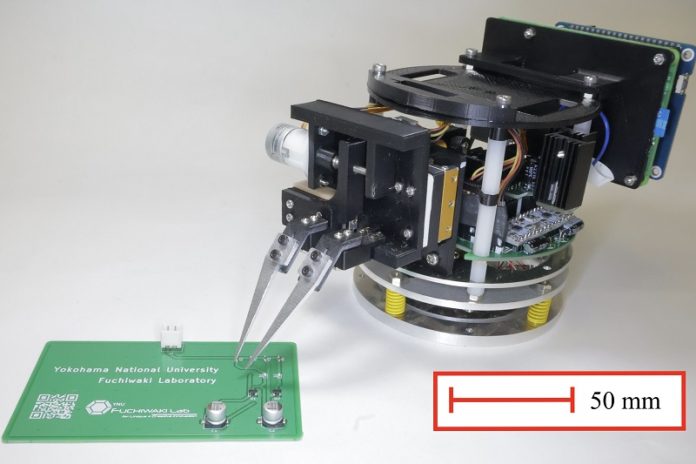
Palm sized untethered autonomous holonomic precise robot for multi-purpose tasks in confined narrow space. Credit: Yokohama National University.
Scientists have developed a tiny, cordless robot inspired by the rhinoceros beetle that can perform incredibly precise tasks in extreme environments.
Named Holonomic Beetle 3 (HB-3), this robot is lightweight, autonomous, and can move in all directions with extreme accuracy.
The new technology could be a game-changer for laboratory automation, medical procedures, and micro-scale manufacturing—especially in places where humans cannot go.
The research team from Yokohama National University in Japan has designed HB-3 to handle microscopic tasks with unmatched precision, making it useful for industries that require extreme accuracy, such as electronics, scientific research, and even space exploration.
Their findings were published in _Advanced Intelligent Systems_ on January 26, 2025.
**Why we need tiny robots like HB-3**
Many industries today require robots that can work at a microscopic level. For example:
* Electronics: As electronic components get smaller, robots need to be able to pick up and place tiny parts without damaging them.
* Medical procedures: Some delicate operations require extreme precision that only micro-robots can achieve.
* Scientific research: Some materials, like nanomaterials and cells, require careful handling at an atomic or molecular scale.
* Hazardous environments: Places like vacuum chambers, cleanrooms, and biohazard safety labs are dangerous or impossible for humans to enter.
Until now, most microscopic positioning devices were large, heavy, and required cables for power. Even though batteries and circuits have become smaller, robotic systems for precision work have not advanced at the same pace. The HB-3 changes that by being completely cordless and self-sufficient while maintaining extreme accuracy.
**How HB-3 works**
At the heart of HB-3’s design is a special type of actuator—the part that moves the robot. The robot uses piezoelectric actuators, which are materials that change shape when exposed to electricity.
Quartz crystals and certain ceramics, like PZT (lead zirconate titanate), can expand or contract with electrical signals, allowing the HB-3 to make ultra-small, precise movements at a nanometer scale.
HB-3 is very small, measuring just 10 cubic centimeters and weighing only 515 grams. It is powered by a built-in single-board computer, eliminating the need for power cables.
A small internal camera and machine learning algorithms allow it to see its environment and adjust its movements in real time—something that previous micro-manipulators could not do.
**Precision performance in extreme conditions**
In tests, HB-3 showed exceptional accuracy when performing delicate tasks like:
* Picking up and placing tiny electronic components
* Using tweezers to move microchips
* Injecting small liquid droplets with extreme precision
The robot achieved an average positioning accuracy of 0.08 mm on the x-axis and 0.16 mm on the y-axis, with a success rate of 87% across all tasks. The tools attached to HB-3 can also be swapped out for screwdrivers, soldering irons, measurement probes, and other precision instruments as needed.
**What’s next for HB-3?**
While HB-3 is already a groundbreaking achievement, its creators believe it can be even better. Associate Professor Ohmi Fuchiwaki and his team aim to:
* Speed up object detection by offloading some tasks to a more powerful external computer.
* Improve processing speed by upgrading from its current Raspberry Pi CPU.
* Enhance movement precision by adding internal side-view and top-view cameras to improve 3D positioning.
**A tiny robot with big potential**
The HB-3’s ability to operate independently in extreme environments while handling micro-scale tasks with extreme precision opens up endless possibilities.
Whether assembling the smallest electronic components, assisting in delicate medical procedures, or working in environments too hazardous for humans, the HB-3 represents a major leap forward in robotics and automation.
With further improvements, this tiny beetle-inspired robot could become a crucial tool for industries that demand high precision, flexibility, and efficiency in the years to come.